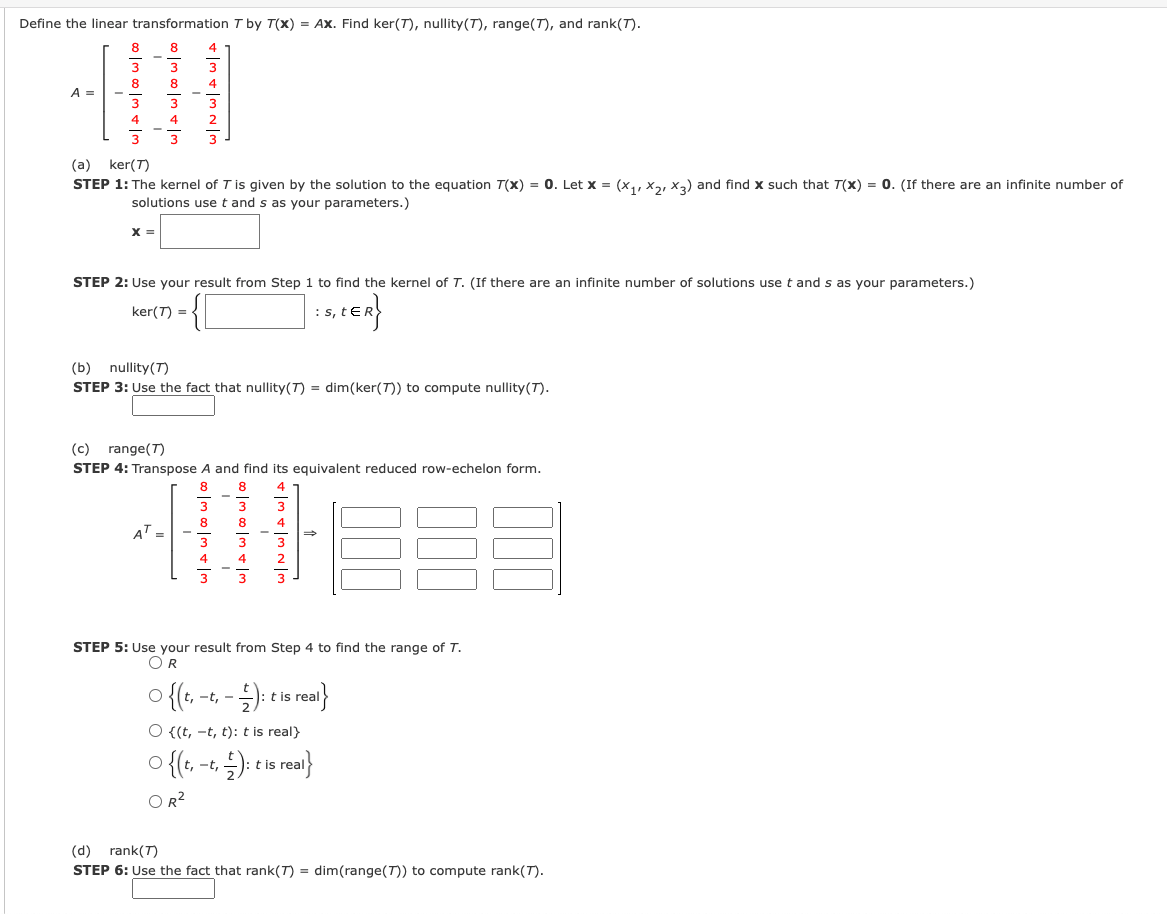Define the linear transformation I by T(x) = Ax. Find ker(T), nullity(T), range(T), and rank(T). 8 8 4 3 3 8 8 4 A = 3 3 4 4 2 3 (a) ker(T) STEP 1: The kernel of T is given by the solution to the equation T(x) = 0. Let x = (x,, Xa, x,) and find x such that T(x) = 0. (If there are an infinite number of solutions use t and s as your parameters.) X = STEP 2: Use your result from Step 1 to find the kernel of T. (If there are an infinite number of solutions use t and s as your parameters.) ker(T) = 3. (b) nullity(T) STEP 3: Use the fact that nullity(T) = dim(ker(T)) to compute nullity(T). (c) range(T) STEP 4: Transpose A and find its equivalent reduced row-echelon form. 8 8 4 4 STEP 5: Use your result from Step 4 to find the range of T. OR
Define the linear transformation I by T(x) = Ax. Find ker(T), nullity(T), range(T), and rank(T). 8 8 4 3 3 8 8 4 A = 3 3 4 4 2 3 (a) ker(T) STEP 1: The kernel of T is given by the solution to the equation T(x) = 0. Let x = (x,, Xa, x,) and find x such that T(x) = 0. (If there are an infinite number of solutions use t and s as your parameters.) X = STEP 2: Use your result from Step 1 to find the kernel of T. (If there are an infinite number of solutions use t and s as your parameters.) ker(T) = 3. (b) nullity(T) STEP 3: Use the fact that nullity(T) = dim(ker(T)) to compute nullity(T). (c) range(T) STEP 4: Transpose A and find its equivalent reduced row-echelon form. 8 8 4 4 STEP 5: Use your result from Step 4 to find the range of T. OR
Linear Algebra: A Modern Introduction
4th Edition
ISBN:9781285463247
Author:David Poole
Publisher:David Poole
Chapter6: Vector Spaces
Section6.5: The Kernel And Range Of A Linear Transformation
Problem 4EQ
Related questions
Question
(
4.
6.2
Pls help thanks

Transcribed Image Text:Define the linear transformation I by T(x) = Ax. Find ker(T), nullity(T), range(T), and rank(T).
8
8
4
3
3
8
8
4
A =
3
3
4
4
3
(a) ker(T)
STEP 1: The kernel of T is given by the solution to the equation T(x) = 0. Let x = (x,, Xa, x,) and find x such that T(x) = 0. (If there are an infinite number of
solutions use t and s as your parameters.)
X =
STEP 2: Use your result from Step 1 to find the kernel of T. (If there are an infinite number of solutions use t and s as your parameters.)
ker(T) =
(b)
nullity(T)
STEP 3: Use the fact that nullity(T) = dim(ker(T)) to compute nullity(T).
(c)
range(T)
STEP 4: Transpose A and find its equivalent reduced row-echelon form.
8
8
8
4T:
4
4
STEP 5: Use your result from Step 4 to find the range of T.
OR
t is
-
O {(t, -t, t): t is real}
>{(, -+, ;); is rea}
-t,
OR?
(d) rank(T)
STEP 6: Use the fact that rank(T) = dim(range(T)) to compute rank(T).
Expert Solution
This question has been solved!
Explore an expertly crafted, step-by-step solution for a thorough understanding of key concepts.
This is a popular solution!
Trending now
This is a popular solution!
Step by step
Solved in 2 steps with 2 images

Recommended textbooks for you

Linear Algebra: A Modern Introduction
Algebra
ISBN:
9781285463247
Author:
David Poole
Publisher:
Cengage Learning

Elementary Linear Algebra (MindTap Course List)
Algebra
ISBN:
9781305658004
Author:
Ron Larson
Publisher:
Cengage Learning

Linear Algebra: A Modern Introduction
Algebra
ISBN:
9781285463247
Author:
David Poole
Publisher:
Cengage Learning

Elementary Linear Algebra (MindTap Course List)
Algebra
ISBN:
9781305658004
Author:
Ron Larson
Publisher:
Cengage Learning